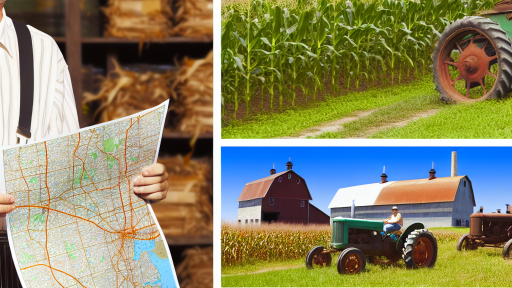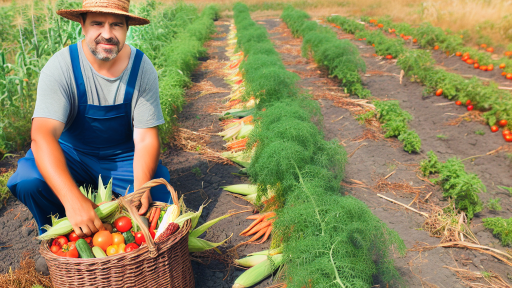Introduction to Natural Pest Control
Natural pest control is essential for small farms.
It offers farmers effective solutions without harsh chemicals.
Moreover, it promotes a healthy ecosystem and biodiversity.
In recent years, more farmers embrace sustainable practices.
This shift is critical for protecting the environment.
Farmers can reduce their dependence on synthetic pesticides.
Consequently, they can lower production costs and increase profits.
Using natural methods also resonates with consumers.
Many customers prefer organic products without chemical residues.
Therefore, implementing natural pest control can boost farm sales.
Benefits of Natural Pest Control
Natural pest control encourages beneficial organisms.
These organisms help regulate pest populations naturally.
In addition, it enhances soil health through ecosystem balance.
Farmers often find improved plant growth and resilience.
Furthermore, natural methods minimize the risk of pest resistance.
Transform Your Agribusiness
Unlock your farm's potential with expert advice tailored to your needs. Get actionable steps that drive real results.
Get StartedThis approach can create long-term solutions for pest management.
Common Methods of Natural Pest Control
Farmers can use several effective natural pest control methods.
Examples include biological control, companion planting, and traps.
Biological control involves introducing natural predators.
This reduces the number of harmful pests significantly.
Companion planting uses specific plant combinations for protection.
For instance, marigolds repel nematodes and other pests.
Additionally, traps can catch pests without chemicals.
Farmers can use pheromone traps or sticky traps effectively.
Challenges and Considerations
While natural pest control holds benefits, challenges exist.
Farmers must carefully monitor pest populations.
Timing and method selection play critical roles in success.
Some methods may require more time to implement.
Moreover, farmers need proper education on best practices.
However, with persistence and knowledge, success is achievable.
Understanding Common Pests in Small Farming
Identifying Common Pests
Small farms face various pest challenges.
Some common pests include aphids, whiteflies, and spider mites.
Aphids are small, sap-sucking insects.
Whiteflies resemble tiny moths and can cause significant plant damage.
Spider mites are incredibly small and fast-spreading pests.
Farmers must be able to quickly identify these pests.
Regular monitoring helps catch infestations early.
Impacts of Pest Infestations
Pests can have severe impacts on crops and yields.
Insect infestations reduce plant health and productivity.
Showcase Your Farming Business
Publish your professional farming services profile on our blog for a one-time fee of $200 and reach a dedicated audience of farmers and agribusiness owners.
Publish Your ProfileFarmers may see significant economic losses if unchecked.
Additionally, pests can spread various plant diseases.
For instance, aphids transmit viral infections among crops.
Effective pest management is crucial for sustainable farming.
Assessing the Severity of Infestations
Farmers should always assess the severity of pest infestations.
This involves checking the number of pests present.
Monitoring damage levels on plants is also essential.
Farmers can then choose appropriate control strategies.
Understanding the life cycle of each pest assists in management.
By doing this, small farmers can mitigate future outbreaks.
Biological Control Methods: Utilizing Natural Predators and Parasites
Understanding Biological Control
Biological control involves using natural enemies to manage pests.
Farmers can introduce beneficial organisms into their fields.
These organisms help maintain balanced ecosystems.
By doing this, farms can reduce reliance on chemical pesticides.
Types of Natural Predators
Many beneficial insects serve as natural predators.
Ladybugs are a popular choice for controlling aphid populations.
Praying mantises can tackle various garden pests effectively.
Hoverfly larvae also feed on aphids, contributing to pest management.
Utilizing Parasites for Pest Management
Parasitoids can significantly suppress pest numbers.
For instance, parasitic wasps lay eggs inside other insects.
This method directly reduces pest populations over time.
Farmers can introduce species that target specific pests.
Creating a Beneficial Environment
To attract natural predators, farms should promote biodiversity.
Planting native flowers encourages pollinators and beneficial insects.
Maintaining habitats like hedgerows and insect hotels supports wildlife.
Impact on Farm Health
Utilizing biological control enhances farm resilience.
It fosters a natural balance within the ecosystem.
Reduced chemical use leads to healthier soil and crops.
Ultimately, these methods contribute to sustainable farming practices.
Learn More: Ethical Animal Farming Practices
Cultural Practices
Crop Rotation
Crop rotation is a vital practice for pest control on small farms.
This method helps disrupt pest life cycles effectively.
By alternating crops, you can reduce pest buildup in the soil.
It also enhances soil fertility, benefiting future crops.
For example, rotating between legumes and grains improves nitrogen levels.
Farmers can also observe which crops attract specific pests.
This knowledge allows for more targeted pest management strategies.
Companion Planting
Companion planting involves growing certain plants together for mutual benefit.
Some plants can repel pests naturally, while others can attract beneficial insects.
For instance, marigolds deter nematodes and other harmful insects.
Showcase Your Farming Business
Publish your professional farming services profile on our blog for a one-time fee of $200 and reach a dedicated audience of farmers and agribusiness owners.
Publish Your ProfileSimilarly, basil can improve the flavor of tomatoes while repelling pests.
Understanding plant relationships can significantly enhance farm biodiversity.
Farmers can create a healthier ecosystem by strategically planting companions.
Soil Health
Maintaining soil health is crucial for natural pest control.
Healthier soil produces stronger, more resilient plants.
Incorporating organic matter increases soil biodiversity.
This diversity can lead to natural predation on harmful pests.
Regular testing can help farmers understand nutrient deficiencies.
Addressing these deficiencies improves overall plant vigor.
Farmers should also consider cover crops to protect and enrich soil.
These practices cumulatively contribute to a robust agricultural environment.
You Might Also Like: Farm-to-School: Boosting Local Farm Economies
Physical Barriers: Using Netting, Traps, and Row Covers
Introduction to Physical Barriers
Physical barriers offer effective methods for pest control on small farms.
These solutions encompass netting, traps, and row covers.
Farmers can utilize these tools to safeguard their crops.
Benefits of Netting
Netting serves as a protective shield against various pests.
It effectively keeps birds, insects, and animals away from crops.
Additionally, netting allows sunlight and rain to reach the plants.
Farmers can choose from various types of netting materials.
These include fine mesh, bird netting, and heavy-duty options.
Implementing Traps
Traps play a vital role in monitoring and managing pest populations.
Farmers can use different types of traps for various pests.
Sticky traps are useful for flying insects like aphids and whiteflies.
On the other hand, bait traps attract and catch rodents effectively.
Regularly changing traps ensures ongoing pest control effectiveness.
Utilizing Row Covers
Row covers provide another layer of protection for crops.
They offer a physical barrier to pests while retaining heat.
This is especially beneficial for tender seedlings in early spring.
Floating row covers are lightweight and easy to manage.
They can help in creating a micro-climate that encourages growth.
Best Practices for Installation
Proper installation of physical barriers enhances their effectiveness.
Ensure that netting is securely fastened around the crop area.
Regularly inspect traps to assess their functionality.
Position row covers to avoid direct contact with the plants.
Avoid allowing any gaps that pests could exploit.
Considerations and Limitations
While physical barriers are effective, they may have limitations.
Netting can become entangled or damaged by strong winds.
Traps may require constant attention and maintenance.
Row covers can restrict airflow if not managed correctly.
Farmers should evaluate their specific needs to determine the best solutions.
Showcase Your Farming Business
Publish your professional farming services profile on our blog for a one-time fee of $200 and reach a dedicated audience of farmers and agribusiness owners.
Publish Your ProfileFind Out More: Agri-Tourism: Connecting Farmers with Consumers
Botanical Insecticides: Efficacy of Plant-Based Solutions
Introduction to Botanical Insecticides
Botanical insecticides derive from plants and are integral to pest management.
They offer a natural alternative to synthetic chemicals.
This approach appeals to small farmers seeking sustainable methods.
Types of Botanical Insecticides
Various plants yield effective insecticides.
- Neem oil comes from the seeds of the neem tree.
- Pyrorural, derived from chrysanthemum flowers, targets a broad range of pests.
- Insecticidal soap uses fatty acids from plant oils to control soft-bodied insects.
How Botanical Insecticides Work
Botanical insecticides disrupt the life cycle of pests.
They may act as deterrents, repellents, or direct toxins.
This action reduces pest populations efficiently.
Effectiveness in Pest Control
Research shows botanical insecticides can be highly effective.
A recent study demonstrated significant pest reduction using neem oil.
Pyrorural also proved effective in controlling aphids and spider mites.
Benefits of Using Natural Solutions
Using botanical insecticides brings various advantages.
- They are generally safe for beneficial insects.
- These solutions break down quickly in the environment.
- They often have minimal impact on human health.
Application and Best Practices
Proper application enhances the effectiveness of botanical insecticides.
Farmers should apply these treatments during the early morning or late evening.
This practice reduces the risk of harming beneficial organisms.
Additionally, rotating different insecticides can help prevent resistance.
Considerations for Use
While effective, botanical insecticides have limitations.
Some plants may require frequent applications for optimal results.
Moreover, specific pests may not be significantly affected by certain ingredients.
Explore Further: Maximizing Yields with Organic Small-Scale Methods

Integrating Technology: Monitoring Pest Populations with Smart Solutions
Understanding Smart Pest Monitoring
Smart pest monitoring leverages technology for effective pest management.
This approach offers real-time data to farmers.
Farmers can make informed decisions using accurate pest population data.
Using sensors and software, it tracks pest activity seamlessly.
Types of Smart Monitoring Solutions
Various solutions are available for small farms.
- Remote sensing technology monitors crop health.
- Smart traps provide alerts about pest presence.
- Mobile apps streamline pest management reporting.
Benefits of Smart Pest Monitoring
Smart monitoring increases efficiency in pest control.
It reduces the reliance on chemical treatments.
This method promotes sustainable farming practices.
Additionally, it saves time and resources for farmers.
Implementation Strategies
Farmers should choose technology that fits their specific needs.
Some solutions offer easy integration with existing systems.
Training staff on these technologies enhances effectiveness.
Regular data analysis improves pest management over time.
Collaborating with Experts
Consulting agricultural technology experts can be beneficial.
They provide guidance on selecting and integrating systems.
Partnerships with local universities can enhance research efforts.
Networking with other farmers helps share best practices.
Case Studies: Success Stories of Natural Pest Control on Small Farms
Introducing Beneficial Insects
On Green Acres Farm, Linda started using ladybugs.
They effectively control aphid populations.
As a result, Linda noticed a 70% reduction in aphid damage within weeks.
Showcase Your Farming Business
Publish your professional farming services profile on our blog for a one-time fee of $200 and reach a dedicated audience of farmers and agribusiness owners.
Publish Your ProfileFurthermore, she observed an increase in plant health and yield.
Organic Pesticides
At Maple Valley, Tom applied neem oil regularly.
This organic solution targeted multiple pests.
His crops thrived without the negative impacts of synthetic chemicals.
Moreover, nearby pollinators remained unharmed, promoting a vibrant ecosystem.
Crop Rotation Techniques
Jane’s Berry Farm implemented crop rotation.
This practice disrupted pest life cycles effectively.
Over three seasons, she reported a significant drop in pest infestations.
Additionally, soil fertility improved, enhancing fruit quality.
Companion Planting
Next, at Sunnydale Farms, Martin used companion planting wisely.
He paired marigolds with tomatoes.
These flowers repelled nematodes and attracted beneficial insects.
Consequently, Martin’s tomato yield increased substantially while needing less pest control.
Integrated Pest Management
At Riverbend Farm, Amy adopted integrated pest management (IPM).
She combined biological, cultural, and mechanical tactics.
This multi-faceted approach minimized pest populations efficiently.
As a result, Amy enjoyed bountiful harvests without harming the environment.
Utilizing Natural Predators
Lastly, at Oak Hollow Farm, David encouraged native bird species.
He installed birdhouses to attract them.
These birds helped control insects naturally, reducing David’s reliance on chemicals.
Consequently, he reported healthier crops and enriched biodiversity.
Sustainable Practices for Long-Term Pest Management
Understanding Natural Pest Control
Natural pest control provides effective solutions for small farms.
It utilizes biological and ecological methods to manage pests.
Farmers can implement a variety of sustainable practices.
For instance, crop rotation enhances soil health and disrupts pest cycles.
This approach minimizes the reliance on chemical pesticides.
Biological Control Methods
Biological control involves using natural enemies of pests.
Beneficial insects like ladybugs can reduce aphid populations.
Birds can also play a vital role in controlling pests.
Encouraging birds can be as simple as providing nesting boxes.
Additionally, farmers can introduce nematodes to target soil-dwelling pests.
Physical and Mechanical Methods
Physical barriers prevent pests from accessing crops.
Using row covers can protect seedlings from insects.
Traps can catch harmful insects effectively.
Moreover, hand-picking larger pests remains an option for small farms.
Soil Health and Plant Diversity
Maintaining healthy soil is crucial for sustainable farming.
Amending soil with organic matter boosts productivity.
This practice supports diverse plant life, which can deter pests.
Intercropping also promotes biodiversity and pest resistance.
Continuous Monitoring and Adaptation
Regular monitoring helps farmers understand pest populations.
Showcase Your Farming Business
Publish your professional farming services profile on our blog for a one-time fee of $200 and reach a dedicated audience of farmers and agribusiness owners.
Publish Your ProfileThis can inform timely interventions when necessary.
Farmers should adapt their strategies based on observations.
Flexibility allows for better outcomes in pest management.
Education and Community Resources
Farmers benefit from educating themselves about pest management.
Participating in workshops can enhance their knowledge.
Community resources, like cooperative extension services, offer support.
Sharing experiences with other farmers helps spread effective strategies.
Benefits of Sustainable Pest Management
Implementing sustainable practices results in healthier ecosystems.
This approach decreases chemical dependencies over time.
Ultimately, it leads to improved crops and profitability.
Investing in natural pest control measures is beneficial for all.
Additional Resources
What is Sustainable Agriculture? | Union of Concerned Scientists
Beyond organic farming – harnessing biodiversity-friendly landscapes




